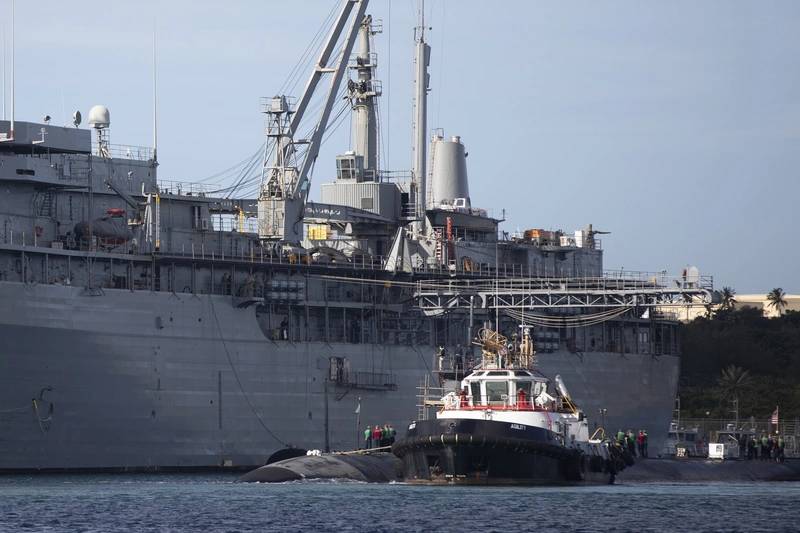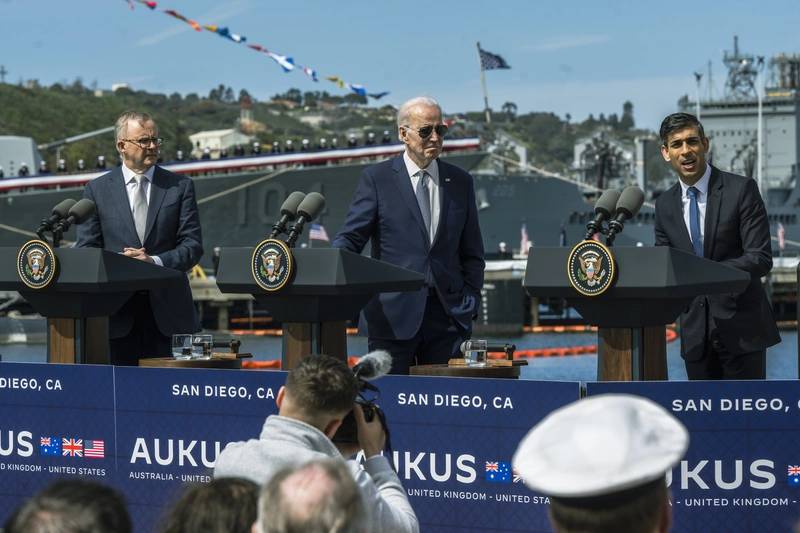U.S. Navy Shipbuilders & Disaggregated, Dispersed Production
With a lame-duck CNO, a divided Congress and the impending launch of the next Presidential election cycle, America’s naval market is locked into something of a fragile and fearful autopilot, cruising inexorably towards whatever excitement 2024 might bring.
Materially, don’t expect much change: The demand for naval platforms will continue to outstrip available funding, meaning there will be little movement or growth in America’s major shipbuilding programs of record. The procurement outlines are already set. One Columbia-class submarine, two Virginia-class submarines, two Arleigh Burke-class destroyers, two Constellation-class frigates, one John Lewis-class oiler and maybe a new submarine tender or a San Antonio-class amphibious vessel will go to their usual builders.

As procurements go, it will be a relatively dull year.
The real excitement in the naval shipbuilding industry over the next 12 months may rest in the gradual acceptance of disaggregated and dispersed production of U.S. naval ships.
American shipbuilders have tried these advanced manufacturing schemes before, with Zumwalt-class (DDG-1000) destroyer deckhouses and other platforms, but, outside of submarines, challenges with secure data transfer, a lack of trust between partners, and other issues limited the adoption of dispersed prefabrication in U.S. naval shipbuilding.
But times, technologies, and attitudes are changing. With government pressure to grow submarine production from the current 1.5 Virginia-class subs a year to two or, preferably, even three attack submarines a year, General Dynamics Electric Boat is already moving beyond their Connecticut and Rhode Island facilities for new sources of submarine modules and large, modular components.

Photo Credit: DoD photo by Chad J. McNeeley
But the pressure is on for General Dynamics to move faster in adopting distributed production.
In the next 12 months, the Australia, United Kingdom, United States (AUKUS) agreement for the transfer of nuclear technology to Australia will reach a boiling point. To keep the landmark agreement from collapsing, America must step up, meet its commitments, and identify two Virginia-class nuclear attack submarines and designate an “in production” submarine from the production line for Australian operation.
That will be a challenge.
With Virginia-class attack submarine production already being sacrificed to keep the Columbia-class strategic ballistic missile submarine program on something near to the planned schedule, U.S. politicians will be reluctant to cut the U.S. fleet for Australia. That means U.S. submarine manufacturers will be left with few options other than to grow their production capabilities in a potentially radical fashion, relying on the dispersed fabrication of submarine modules and components.
The second driver of dispersed or disaggregated naval production may prove to be the Constellation-class frigate. The verdict, of course, is still out. Neither the Navy nor the ship’s builder, Fincantieri Marine Group, have determined if they want to pursue a second conventional shipyard or if they might prefer to explore some type of regional, dispersed shipyard network or, potentially, even something even more widely disaggregated.
The third driver will be the centralized shipyards themselves.
Successes are ignored.
Neither Philly Shipyard nor the U.S. government is really publicizing the on-time and on-budget National Security Multi-Mission Vessel program, for example, while headwinds at traditional shipyards will capture far greater public interest.
Headwinds are coming.
According to the GAO, Eastern Shipbuilding Group, a builder of the Heritage-class Offshore Patrol Cutter, is still apparently “scheduled to deliver the lead ship in June 2023,” but the first-in-class Offshore Patrol Cutter Argus is still high-and-dry waiting to launch. The Coast Guard’s high-profile Polar Security Cutter program is struggling and facing real challenges. On the East Coast, Bath Ironworks, a relatively traditional shipyard, will begin renegotiating a labor contract this year, but their Maine workforce is restive and already threatening to strike.
In addition, weather may also shake up America’s big, centralized shipyards. While NOAA is boosting its predictive abilities this year, offering a larger window for shipyard emergency managers to batten down at-risk shipyards, unusually hot Atlantic and Caribbean waters will supercharge any cyclones that get within striking distance of America’s military shipyards on the Gulf Coast.
So, while the time may be right for getting more—and potentially untraditional manufacturers into shipbuilding, the operational framework isn’t completely set. Bollinger Shipyards is following a dispersed model, creating a mutually supportive shipyard network across the Gulf Coast. Austal USA is attempting a hybrid model, maintaining a centralized shipyard complex while supporting disaggregated submarine manufacturing, aircraft carrier components and unmanned systems.
Finding the right mix of manufacturing methods will be a challenge, but this year may prove to be the year public perceptions veer away from the idea that ships must be built in single-site “do-it-all” shipyards.
- “Given that efforts to make a profit and efforts to maliciously constrain a rival’s military growth can be virtually one and the same, the U.S. government, in the event of a big financial move, may need to step in, slow things down, and take the time to really examine just who, exactly, may be backing these big investments. “
Photo courtesy of Austal USA
Does A Larger Shipbuilding Reorganization Loom?
The vagaries of the hedge and private equity funds may also drive big changes in the U.S. naval shipbuilding industry. As deep-pocketed investors take big positions and ponder the potential for converting U.S. naval uncertainty into profit, these players could upend U.S. shipbuilding in a matter of months.
Changes are coming.
The Australian parent of Austal USA, Austal LTD, is discussing opportunities to privatize the company. Suitors include Arlington Capital Partners, the well-connected Cerberus Capital Management, to Australian diplomat Joe Hockey and his Bondi Partners firm. With AUKUS, a strong order book, an aging founder and an enormous amount of investor interest, Austal may well see an ownership change over the next year.
On the repair side, global investment firm Carlyle and private equity firm Stellex Capital Management, after extracting residual value from ship repair companies MHI Holdings and Vigor Industrial, is in the process of selling the entire group, renamed Titan Acquisition Holdings, to the distressed entity specialists at Lone Star Funds.
Shipbuilder suppliers are in play as well.
A bidding war for Circor International, a Massachusetts-based supplier of flow control products, threatened to consolidate an already-small constellation of shipyard suppliers. The resulting battle between the suitors, Arcline Investment Management and KKR and Co, shows just how high the stakes might become.
KKR won, agreeing to pay Circor shareholders $56 per share, but, after initially offering shareholders $51 a share, the win was painful. On the other hand, had Arcline been successful, the investment company, which already owns Fairbanks Morse Defense, would have seized an effective monopoly over the valve market. The battle still may not be over, but no matter how the transaction plays out, the winner will rush to make good on their new investments, which suggests price increases are going to flow down to shipbuilders and their customers.
With powerful financial “movers and shakers” taking an interest in the consolidation and recrafting of the defense industrial base, the potential for rapid, whipsaw changes will increase. The Circor battle played out in the space of 112 months, with the final bidding war taking little more than a month. At that pace, regulators will be hard-pressed to keep up—and they should, as these large financial powerhouses can distort the playing field and fundamentally change the naval shipbuilding industry in an afternoon.
There are several reasons to pay attention.
- First, these enormously powerful financial entities are highly integrated into governments and political processes, opening these entities to the regulatory risk that they are employing insider information … or worse.
- Second, the short-term time horizon and the constant press by these companies to offer maximum returns on investments may constrain shipyard innovation. Vigor, before it was sold off, was one of the more dynamic shoreside players in the American maritime. With facilities scattered across America’s western coastline, it was busy expanding, diversifying, and starting to explore the idea of advanced dispersed/disaggregated shipbuilding. All that came to a halt after the sale. And today, with private equity in the hunt for Austal, that “on the move” shipyard may see its efforts to innovate strangled by a strict focus on the bottom line.
- Third, the actual ownership and interest of these large and complex financial entities is often impossible to penetrate. And as more and more countries start identifying supplier chokepoints and defense industrial bottlenecks, the potential for wide-ranging fiscal mischief will grow. And, given that efforts to make a profit and efforts to maliciously constrain a rival’s military growth can be virtually one and the same, the U.S. government, in the event of a big financial move, may need to step in, slow things down, and take the time to really examine just who, exactly, may be backing these big investments.
So, while the year ahead in naval shipbuilding may be on autopilot, the seas are threatening, and the currents are tricky. But, with a good lookout, there are profits to be made even if the overall U.S. naval marketplace seems relatively calm and unexciting.
Image Credit: Rendering from January 2021 courtesy of Fincantieri Marine Group/Released
